Optimization of Vacuum-Microwave-Assisted Extraction of Natural Polyphenols and Flavonoids from Raw Solid Waste of the Orange Juice Producing Industry at Industrial Scale
Abstract
1. Introduction
2. Results
2.1. Predictive Modeling and Optimization of the Extracted Amount of Orange Pomace (OP) Total Polyphenols
- Microwave power: 5999.997 W,
- Water to orange pomace ratio = 26.09
- Extraction Time: 120.00 min
| A/A | Microwave Power | *** Water-to-Solid Ratio | Extraction Time (min) | * Amount of Total Polyphenols in the Extract Expressed as Gallic Acid Equivalents (mg GA) | ** Amount of Total Flavonoids in the OP Extract Expressed as Quercetin Equivalent (mg QE) | Rate of Extraction of OP Total Polyphenols (mg GAE Kg−1 min−1) | Rate of Extraction of Orange Pomace Total Flavonoids (mg QE Kg−1 min−1) |
|---|---|---|---|---|---|---|---|
| 1 | 4000.00 | 20.00 | 15.00 | 8480 ± 121 | 630.3 ± 58 | 141.333 ± 2.02 | 10.505 ± 0.97 |
| 2 | 4000.00 | 20.00 | 30.00 | 9280 ± 132 | 877.58 ± 101 | 103.111 ± 1.47 | 9.75089 ± 1.12 |
| 3 | 4000.00 | 20.00 | 45.00 | 9760 ± 98 | 1229.09 ± 124 | 81.3333 ± 0.82 | 10.2424 ± 1.03 |
| 4 | 4000.00 | 20.00 | 60.00 | 10,240 ± 82 | 1517.58 ± 134 | 68.2667 ± 0.55 | 10.1172 ± 0.89 |
| 5 | 4000.00 | 20.00 | 75.00 | 10,480 ± 93 | 1949.09 ± 121 | 58.2222 ± 0.52 | 10.8283 ± 0.67 |
| 6 | 4000.00 | 20.00 | 90.00 | 10,800 ± 112 | 710.3 ± 76 | 51.4286 ± 0.53 | 3.38238 ± 0.36 |
| 7 | 4000.00 | 20.00 | 120.00 | 11,040 ± 65 | 576.97 ± 91 | 40.8889 ± 0.24 | 2.13693 ± 0.34 |
| 8 | 2000.00 | 30.00 | 15.00 | 8160 ± 84 | 690.91 ± 61 | 136 ± 1.40 | 11.5152 ± 1.02 |
| 9 | 2000.00 | 30.00 | 30.00 | 8640 ± 105 | 899.39 ± 72 | 96 ± 1.17 | 9.99322 ± 0.80 |
| 10 | 2000.00 | 30.00 | 45.00 | 9520 ± 132 | 1231.52 ± 123 | 79.3333 ± 1.10 | 10.2627 ± 1.03 |
| 11 | 2000.00 | 30.00 | 60.00 | 9920 ± 64 | 1481.21 ± 115 | 66.1333 ± 0.43 | 9.87473 ± 0.77 |
| 12 | 2000.00 | 30.00 | 75.00 | 9600 ± 76 | 1922.42 ± 131 | 53.3333 ± 0.42 | 10.6801 ± 0.73 |
| 13 | 2000.00 | 30.00 | 90.00 | 10,720 ± 123 | 768.48 ± 76 | 51.0476 ± 0.59 | 3.65943 ± 0.36 |
| 14 | 2000.00 | 30.00 | 120.00 | 10,800 ± 102 | 620.61 ± 73 | 40 ± 0.38 | 2.29856 ± 0.27 |
| 15 | 6000.00 | 30.00 | 15.00 | 8320 ± 78 | 218.18 ± 43 | 138.667 ± 1.30 | 3.63633 ± 0.72 |
| 16 | 6000.00 | 30.00 | 30.00 | 10,080 ± 103 | 300.61 ± 34 | 112 ± 1.14 | 3.34011 ± 0.38 |
| 17 | 6000.00 | 30.00 | 45.00 | 10,400 ± 86 | 409.7 ± 51 | 86.6667 ± 0.72 | 3.41417 ± 0.43 |
| 18 | 6000.00 | 30.00 | 60.00 | 10,400 ± 58 | 705.45 ± 112 | 69.3333 ± 0.39 | 4.703 ± 0.75 |
| 19 | 6000.00 | 30.00 | 75.00 | 10,080 ± 89 | 375.76 ± 43 | 56 ± 0.49 | 2.08756 ± 0.24 |
| 20 | 6000.00 | 30.00 | 90.00 | 12,080 ± 104 | 460.61 ± 52 | 57.5238 ± 0.50 | 2.19338 ± 0.25 |
| 21 | 6000.00 | 30.00 | 120.00 | 12,800 ± 134 | 460.61 ± 47 | 47.4074 ± 0.50 | 1.70596 ± 0.17 |
| 22 | 4000.00 | 30.00 | 15.00 | 8640 ± 87 | 630.3 ± 71 | 144 ± 1.45 | 10.505 ± 1.18 |
| 23 | 4000.00 | 30.00 | 30.00 | 9040 ± 97 | 295.76 ± 22 | 100.444 ± 1.08 | 3.28622 ± 0.24 |
| 24 | 4000.00 | 30.00 | 45.00 | 9760 ± 101 | 317.58 ± 41 | 81.3333 ± 0.84 | 2.6465 ± 0.34 |
| 25 | 4000.00 | 30.00 | 60.00 | 9760 ± 69 | 378.18 ± 52 | 65.0667 ± 0.46 | 2.5212 ± 0.35 |
| 26 | 4000.00 | 30.00 | 75.00 | 10,400 ± 114 | 375.76 ± 43 | 57.7778 ± 0.63 | 2.08756 ± 0.24 |
| 27 | 4000.00 | 30.00 | 90.00 | 11,040 ± 87 | 392.73 ± 52 | 52.5714 ± 0.41 | 1.87014 ± 0.25 |
| 28 | 4000.00 | 30.00 | 120.00 | 10,800 ± 93 | 450.91 ± 23 | 40 ± 0.34 | 1.67004 ± 0.09 |
| 29 | 2000.00 | 10.00 | 15.00 | 7680 ± 111 | 173.33 ± 25 | 128 ± 1.85 | 2.88883 ± 0.42 |
| 30 | 2000.00 | 10.00 | 30.00 | 8040 ± 132 | 214.55 ± 31 | 89.3333 ± 1.47 | 2.38389 ± 0.34 |
| 31 | 2000.00 | 10.00 | 45.00 | 8320 ± 86 | 200 ± 23 | 69.3333 ± 0.72 | 1.66667 ± 0.19 |
| 32 | 2000.00 | 10.00 | 60.00 | 8440 ± 75 | 256.97 ± 33 | 56.2667 ± 0.50 | 1.71313 ± 0.22 |
| 33 | 2000.00 | 10.00 | 90.00 | 8960 ± 83 | 260.61 ± 21 | 42.6667 ± 0.40 | 1.241 ± 0.10 |
| 34 | 2000.00 | 10.00 | 120.00 | 8680 ± 64 | 246.06 ± 26 | 32.1481 ± 0.24 | 0.911333 ± 0.10 |
| 35 | 4000.00 | 10.00 | 15.00 | 9600 ± 73 | 272.73 ± 41 | 160 ± 1.22 | 4.5455 ± 0.68 |
| 36 | 4000.00 | 10.00 | 30.00 | 8880 ± 101 | 305.45 ± 15 | 98.6667 ± 1.12 | 3.39389 ± 0.17 |
| 37 | 4000.00 | 10.00 | 45.00 | 9000 ± 85 | 443.64 ± 25 | 75 ± 0.71 | 3.697 ± 0.21 |
| 38 | 4000.00 | 10.00 | 60.00 | 9960 ± 91 | 461.82 ± 27 | 66.4 ± 0.61 | 3.0788 ± 0.18 |
| 39 | 4000.00 | 10.00 | 75.00 | 10,320 ± 121 | 469.09 ± 36 | 57.3333 ± 0.67 | 2.60606 ± 0.20 |
| 40 | 4000.00 | 10.00 | 90.00 | 11,160 ± 112 | 469.09 ± 41 | 53.1429 ± 0.53 | 2.23376 ± 0.20 |
| 41 | 6000.00 | 20.00 | 15.00 | 8760 ± 103 | 261.82 ± 27 | 146 ± 1.72 | 4.36367 ± 0.45 |
| 42 | 6000.00 | 20.00 | 30.00 | 9960 ± 85 | 247.27 ± 32 | 110.667 ± 0.94 | 2.74744 ± 0.36 |
| 43 | 6000.00 | 20.00 | 45.00 | 10,800 ± 126 | 363.64 ± 21 | 90 ± 1.05 | 3.03033 ± 0.18 |
| 44 | 6000.00 | 20.00 | 75.00 | 12,360 ± 132 | 341.82 ± 26 | 68.6667 ± 0.73 | 1.899 ± 0.14 |
| 45 | 6000.00 | 20.00 | 90.00 | 13,320 ± 98 | 374.55 ± 32 | 63.4286 ± 0.47 | 1.78357 ± 0.15 |
| 46 | 6000.00 | 20.00 | 120.00 | 13,800 ± 95 | 334.55 ± 41 | 51.1111 ± 0.35 | 1.23907 ± 0.15 |
| 47 | 6000.00 | 10.00 | 15.00 | 6560 ± 76 | 133.33 ± 21 | 109.333 ± 1.27 | 2.22217 ± 0.35 |
| 48 | 6000.00 | 10.00 | 30.00 | 7640 ± 81 | 178.18 ± 11 | 84.8889 ± 0.90 | 1.97978 ± 0.12 |
| 49 | 6000.00 | 10.00 | 45.00 | 7480 ± 73 | 189.09 ± 16 | 62.3333 ± 0.61 | 1.57575 ± 0.13 |
| 50 | 6000.00 | 10.00 | 60.00 | 8080 ± 97 | 192.73 ± 21 | 53.8667 ± 0.65 | 1.28487 ± 0.14 |
| 51 | 6000.00 | 10.00 | 75.00 | 7640 ± 71 | 220.61 ± 31 | 42.4444 ± 0.39 | 1.22561 ± 0.17 |
| 52 | 6000.00 | 10.00 | 90.00 | 8240 ± 104 | 318.79 ± 11 | 39.2381 ± 0.50 | 1.51805 ± 0.05 |
| 53 | 6000.00 | 10.00 | 120.00 | 8600 ± 73 | 233.94 ± 13 | 31.8519 ± 0.27 | 0.866444 ± 0.05 |
| 54 | 4000.00 | 20.00 | 15.00 | 8560 ± 86 | 613.33 ± 16 | 142.667 ± 1.43 | 10.2222 ± 0.27 |
| 55 | 4000.00 | 20.00 | 30.00 | 9280 ± 91 | 836.36 ± 32 | 103.111 ± 1.01 | 9.29289 ± 0.36 |
| 56 | 4000.00 | 20.00 | 45.00 | 9120 ± 94 | 1236.36 ± 37 | 76 ± 0.78 | 10.303 ± 0.31 |
| 57 | 4000.00 | 20.00 | 60.00 | 10,240 ± 128 | 1541.82 ± 82 | 68.2667 ± 0.85 | 10.2788 ± 0.55 |
| 58 | 4000.00 | 20.00 | 75.00 | 10,080 ± 121 | 1927.27 ± 56 | 56 ± 0.67 | 10.7071 ± 0.31 |
| 59 | 4000.00 | 20.00 | 90.00 | 11,040 ± 89 | 671.52 ± 31 | 52.5714 ± 0.42 | 3.19771 ± 0.15 |
| 60 | 4000.00 | 20.00 | 120.00 | 10,560 ± 115 | 545.45 ± 21 | 39.1111 ± 0.43 | 2.02019 ± 0.08 |
| 61 | 2000.00 | 20.00 | 15.00 | 9200 ± 123 | 749.09 ± 72 | 153.333 ± 2.05 | 12.4848 ± 1.20 |
| 62 | 2000.00 | 20.00 | 30.00 | 9120 ± 111 | 1129.7 ± 103 | 101.333 ± 1.23 | 12.5522 ± 1.14 |
| 63 | 2000.00 | 20.00 | 45.00 | 9440 ± 87 | 1343.03 ± 97 | 78.6667 ± 0.73 | 11.1919 ± 0.81 |
| 64 | 2000.00 | 20.00 | 60.00 | 9360 ± 91 | 1575.76 ± 84 | 62.4 ± 0.61 | 10.5051 ± 0.56 |
| 65 | 2000.00 | 20.00 | 75.00 | 11,200 ± 115 | 1934.55 ± 115 | 62.2222 ± 0.64 | 10.7475 ± 0.64 |
| 66 | 2000.00 | 20.00 | 90.00 | 10,560 ± 111 | 683.64 ± 52 | 50.2857 ± 0.53 | 3.25543 ± 0.25 |
| 67 | 2000.00 | 20.00 | 120.00 | 10,880 ± 87 | 656.97 ± 23 | 40.2963 ± 0.32 | 2.43322 ± 0.09 |
| 68 | 4000.00 | 20.00 | 15.00 | 9280 ± 121 | 673.94 ± 28 | 154.667 ± 2.02 | 11.2323 ± 0.47 |
| 69 | 4000.00 | 20.00 | 30.00 | 9360 ± 114 | 1095.76 ± 104 | 104 ± 1.27 | 12.1751 ± 1.16 |
| 70 | 4000.00 | 20.00 | 45.00 | 9680 ± 74 | 1318.79 ± 121 | 80.6667 ± 0.62 | 10.9899 ± 1.01 |
| 71 | 4000.00 | 20.00 | 60.00 | 10,160 ± 102 | 1604.85 ± 140 | 67.7333 ± 0.68 | 10.699 ± 0.93 |
| 72 | 4000.00 | 20.00 | 75.00 | 10,720 ± 116 | 1854.55 ± 117 | 59.5556 ± 0.64 | 10.3031 ± 0.65 |
| 73 | 4000.00 | 20.00 | 90.00 | 10,240 ± 121 | 722.42 ± 41 | 48.7619 ± 0.58 | 3.4401 ± 0.20 |
| 74 | 4000.00 | 20.00 | 120.00 | 10,800 ± 117 | 686.06 ± 52 | 40 ± 0.43 | 2.54096 ± 0.19 |
| 75 | 4000.00 | 20.00 | 30.00 | 10,680 ± 89 | 334.55 ± 21 | 118.667 ± 0.99 | 3.71722 ± 0.23 |
| 76 | 4000.00 | 20.00 | 45.00 | 11,040 ± 113 | 378.18 ± 19 | 92 ± 0.94 | 3.1515 ± 0.16 |
| 77 | 4000.00 | 20.00 | 60.00 | 11,040 ± 121 | 560 ± 18 | 73.6 ± 0.81 | 3.73333 ± 0.12 |
| 78 | 4000.00 | 20.00 | 75.00 | 10,440 ± 109 | 658.18 ± 41 | 58 ± 0.61 | 3.65656 ± 0.23 |
| 79 | 4000.00 | 20.00 | 90.00 | 11,760 ± 118 | 530.91 ± 38 | 56 ± 0.56 | 2.52814 ± 0.18 |
| 80 | 4000.00 | 20.00 | 120.00 | 11,280 ± 76 | 450.91 ± 33 | 41.7778 ± 0.28 | 1.67004 ± 0.12 |
| Sum of Squares | df | Mean Square | F-Value | p-Value | ||
|---|---|---|---|---|---|---|
| Model | 0.0000 | 12 | 2.694 × 10−6 | 29.68 | <0.0001 | significant |
| A—MICROWAVE POWER | 1.232 × 10−6 | 1 | 1.232 × 10−6 | 13.57 | 0.0005 | |
| B—WATER-TO-POMACE RATIO | 1.453 × 10−8 | 1 | 1.453 × 10−8 | 0.1601 | 0.6903 | |
| C—EXTRACTION TIME | 3.906 × 10−6 | 1 | 3.906 × 10−6 | 43.04 | <0.0001 | |
| AB | 1.492 × 10−6 | 1 | 1.492 × 10−6 | 16.44 | 0.0001 | |
| AC | 4.464 × 10−7 | 1 | 4.464 × 10−7 | 4.92 | 0.0300 | |
| BC | 3.538 × 10−7 | 1 | 3.538 × 10−7 | 3.90 | 0.0525 | |
| A² | 2.789 × 10−7 | 1 | 2.789 × 10−7 | 3.07 | 0.0842 | |
| B² | 4.149 × 10−6 | 1 | 4.149 × 10−6 | 45.71 | <0.0001 | |
| C² | 9.562 × 10−7 | 1 | 9.562 × 10−7 | 10.54 | 0.0018 | |
| A²B | 2.560 × 10−6 | 1 | 2.560 × 10−6 | 28.21 | <0.0001 | |
| A²C | 3.512 × 10−7 | 1 | 3.512 × 10−7 | 3.87 | 0.0533 | |
| AB² | 8.331 × 10−7 | 1 | 8.331 × 10−7 | 9.18 | 0.0035 | |
| Residual | 6.081 × 10−6 | 67 | 9.076 × 10−8 | |||
| Lack of Fit | 4.673 × 10−6 | 47 | 9.942 × 10−8 | 1.41 | 0.2024 | not significant |
| Pure Error | 1.408 × 10−6 | 20 | 7.042 × 10−8 | |||
| Cor Total | 0.0000 | 79 |
- Type of polynomial Model: Reduced Cubic model
- Response: AMOUNT OF EXTRACTED OP TOTAL POLYPHENOLS (mg/2 kg raw OP)
- Transform: Inverse Sqrt
- Constant: 0
- Fit Statistics
| Std. Dev. | 0.0003 | R² | 0.8417 |
| Mean | 0.0101 | Adjusted R² | 0.8133 |
| C.V. % | 2.97 | Predicted R² | 0.7705 |
| Adeq Precision | 27.7094 |
2.2. Predictive Modeling and Optimization of the Extracted Amount of OP Total Flavonoids
- Microwave power: 2000 Watt
- Water to solid orange pomace ratio: 24.12
- Extraction time: 53.45 min
| ANOVA for Response Surface | ||||||
|---|---|---|---|---|---|---|
| Analysis of Variance Table [Partial Sum of Squares-Type III] | ||||||
| Source | Sum of Squares | df | Mean Square | F Value | p-Value | |
| Model | 0.016 | 12 | 1.30 | 32.98 | <0.0001 | Significant |
| A—MICROWAVE POWER | 1.86 | 1 | 1.86 | 47.37 | <0.0001 | |
| B—WATER TO POMAVE RATIO | 4.00 × 10−3 | 1 | 4.00 × 10−3 | 0.10 | 0.7506 | |
| C—EXTRACTION TIME | 1.19 × 10−3 | 1 | 1.19 × 10−3 | 0.030 | 0.8624 | |
| AB | 3.63 × 10−1 | 1 | 3.63 × 10−1 | 9.24 | 0.0034 | |
| AC | 2.43 × 10−1 | 1 | 2.43 × 10−1 | 6.19 | 0.0153 | |
| BC | 1.29 × 10−1 | 1 | 1.29 × 10−1 | 3.27 | 0.0749 | |
| A2 | 6.82 × 10−1 | 1 | 6.82 × 10−1 | 17.35 | <0.0001 | |
| B2 | 2.79 | 1 | 2.79 | 70.92 | <0.0001 | |
| C2 | 8.46 × 10−1 | 1 | 8.46 | 21.52 | <0.0001 | |
| A2B | 1.68 | 1 | 1.68 | 42.65 | <0.0001 | |
| AB2 | 3.62 × 10−1 | 1 | 3.62 × 10−1 | 9.21 | 0.0034 | |
| B2C | 2.60 × 10−1 | 1 | 2.60 × 10−1 | 6.60 | 0.0124 | |
| Residual | 2.63 | 67 | 3.93 × 10−2 | |||
| Lack of Fit | 1.38 | 47 | 2.94 × 10−2 | 0.47 | 0.9826 | Not Significant |
| Pure Error | 1.25 | 20 | 6.25 × 10−2 | |||
| Cor Total | 0.018 | 79 | ||||
- Type of polynomial model: reduced cubic model
- Response: AMOUNT OF EXTRACTED OP TOTAL FLAVONOIDS (mg QE per 2 kg raw OP)
- Transform: Inverse Sqrt
- Constant: 0
- Fit Statistics
| Std. Dev. | 6.27 | R-Squared | 0.8552 |
| Mean | 0.046 | Adj R-Squared | 0.8293 |
| C.V. % | 13.72 | Pred R-Squared | 0.8105 |
| PRESS | 3.45 | Adeq Precision | 23.712 |
2.3. Simultaneous Optimization of Total Polyphenols Content and Total Flavonoids Content of OP Extracts
- Microwave Power: 2000.00 W
- Water to solid orange pomace ratio: 24.95
- Extraction Time: 63.96 min
2.4. The Economic Optimization of the OP VMA Extraction at Industrial Scale and the Determination of the Corresponding Optimum Values of Extraction Conditions to Obtain Maximum Rates of Extraction (Productivities) for OP Total Polyphenols and OP Total Flavonoids Respectively
2.4.1. Maximization of the Rate of the Extraction (Productivity) of Raw OP Total Polyphenols
| Source | Sum of Squares | df | Mean Square | F-Value | p-Value | |
|---|---|---|---|---|---|---|
| Model | 13.00 | 13 | 0.9997 | 281.68 | <0.0001 | Significant |
| A-MICROWAVE POWER | 0.0551 | 1 | 0.0551 | 15.53 | 0.0002 | |
| B-WATER TO OP RATIO | 0.0007 | 1 | 0.0007 | 0.2030 | 0.6538 | |
| C-EXTRACTION TIME | 1.12 | 1 | 1.12 | 314.89 | <0.0001 | |
| AB | 0.0540 | 1 | 0.0540 | 15.22 | 0.0002 | |
| AC | 0.0200 | 1 | 0.0200 | 5.64 | 0.0205 | |
| BC | 0.0183 | 1 | 0.0183 | 5.15 | 0.0265 | |
| A² | 0.0070 | 1 | 0.0070 | 1.96 | 0.1662 | |
| B² | 0.1607 | 1 | 0.1607 | 45.28 | <0.0001 | |
| C² | 0.6004 | 1 | 0.6004 | 169.18 | <0.0001 | |
| A²B | 0.0921 | 1 | 0.0921 | 25.95 | <0.0001 | |
| A²C | 0.0136 | 1 | 0.0136 | 3.84 | 0.0544 | |
| AB² | 0.0336 | 1 | 0.0336 | 9.47 | 0.0030 | |
| C³ | 0.0720 | 1 | 0.0720 | 20.29 | <0.0001 | |
| Residual | 0.2342 | 66 | 0.0035 | |||
| Lack of Fit | 0.1770 | 46 | 0.0038 | 1.34 | 0.2394 | Not Significant |
| Pure Error | 0.0573 | 20 | 0.0029 | |||
| Cor Total | 13.23 | 79 |
- Response: TOTAL OP POLYPHENOLS PRODUCTIVITY (mg GAE kg−1 min−1)
- Transform: Natural Log
- Constant: 0
| Ln (POLYPHENOLS PRODUCTIVITY in mg GAE kg−1raw OP min−1) = | |
| +4.68567 | |
| +0.000399 | × MICROWAVE POWER |
| +0.017730 | × WATER TO POMACE RATIO |
| −0.033546 | × EXTRACTION TIME |
| −(6.00198 × 10−6) | × MICROWAVE POWER × WATER TO POMACE RATIO |
| −(1.25585 × 10−6) | × MICROWAVE POWER × EXTRACTION TIME |
| +0.000066 | × WATER TO POMACE RATIO × EXTRACTION TIME |
| −(6.95551 × 10−8) | × MICROWAVE POWER2 |
| +0.000278 | × WATER TO POMACE RATIO2 |
| +0.000285 | × EXTRACTION TIME2 |
| +(2.58285 × 10−9) | × MICROWAVE POWER2 × WATER TO POMACE RATIO |
| +(1.97819 × 10−10) | × MICROWAVE POWER 2 × EXTRACTION TIME |
| −(3.10450 × 10−7) | × MICROWAVE POWER × WATER TO POMACE RATI2 |
| −(1.02940 × 10−6) | × EXTRACTION TIME3 |
- Microwave power: 4484.777 W
- Water to solid orange pomace ratio: 19.619
- Extraction Time: 15.00 min
- The optimum rate of OP total polyphenols extraction (maximum productivity) 154.074 mg GAE Kg−1 min−1.
2.4.2. Maximization of the Rate of the Extraction (Productivity) of Raw OP Total Flavonoids
| ANOVA for Response Surface Reduced Cubic Model | ||||||
|---|---|---|---|---|---|---|
| Analysis of Variance Table [Partial Sum of Squares-Type III] | ||||||
| Source | Sum of Squares | df | Mean Square | F Value | p-Value | |
| Model | 2.86 | 9 | 0.32 | 56.17 | <0.0001 | Significant |
| A—MICROWAVE POWER | 0.26 | 1 | 0.26 | 45.33 | <0.0001 | |
| B—WATER TO POMACE RATIO | 4.61 × 10−1 | 1 | 4.61 × 10−1 | 0.081 | 0.7762 | |
| C—EXTRACTION TIME | 0.99 | 1 | 0.99 | 175.59 | <0.0001 | |
| AB | 0.047 | 1 | 0.047 | 8.22 | 0.0055 | |
| A2 | 0.080 | 1 | 0.080 | 14.07 | 0.0004 | |
| B2 | 0.41 | 1 | 0.41 | 72.45 | <0.0001 | |
| C2 | 0.050 | 1 | 0.050 | 8.75 | 0.0042 | |
| A2B | 0.24 | 1 | 0.24 | 41.80 | <0.0001 | |
| AB2 | 0.052 | 1 | 0.052 | 9.13 | 0.0035 | |
| Residual | 0.40 | 70 | 5.66 | |||
| Lack of Fit | 0.23 | 50 | 4.62 | 0.56 | 0.9505 | Not Significant |
| Pure Error | 0.17 | 20 | 8.27 | |||
| Cor Total | 3.26 | 79 | ||||
- Response: OP TOTAL FLAVONOIDS PRODUCTIVITY (mg QE kg−1 min−1)
- Transform: Inverse Sqrt
| Std. Dev. | 0.075 | R-Squared | 0.8784 |
| Mean | 0.55 | Adj R-Squared | 0.8627 |
| C.V. % | 13.77 | Pred R-Squared | 0.8500 |
| PRESS | 0.49 | Adeq Precision | 31.686 |
- Microwave power: 2000.00 W
- Water to solid orange pomace ratio: 24.35
- Extraction time: 15.00 min
2.5. Validation of the Mathematical Models Developed to Predict the Extracted Amount of OP Total Polyphenols and OP Total Flavonoids as Well as the Productivities of the OP VMAE Concerning Total Polyphenols and Flavonoids
3. Discussion
3.1. The Effect of Process Parameters on the Extracted Amounts of OP Total Polyphenols and Flavonoids by Industrial Scale VMAE Extraction
3.2. The Effect of Process Parameters on the Productivities of the Industrial Scale VMAE Extraction of Raw OP Total Polyphenols and Flavonoids
3.3. Comparison of the Optimized Values of Extracted OP Total Polyphenols and Flavonoids of the Present Research Work with the Results Corresponding to Previous Works
3.4. Comparison of the Model Derived in the Present Work with Models Suggested in the Literature
3.5. Summary of the Points of Novelty of the Present Research Work
4. Materials and Methods
4.1. Orange Pomace
4.2. Description of the Microwave Extractor and of the Extraction Methodology
4.3. Total Polyphenols Determination Method
4.4. Total Flavonoids Determination Method
4.5. Chemicals Used for Antioxidant Tests
4.6. Modeling and Optimization Methodology
- Modeling and optimization of total orange pomace polyphenol extraction;
- Modeling and optimization of total orange pomace flavonoids extraction;
- Simultaneous optimization of total orange pomace polyphenols, total flavonoids;
- Modeling and optimization (maximization) of the rate of extraction of orange pomace polyphenols to achieve the maximum productivity (economic optimum);
- Modeling and optimization (maximization) of the rate of extraction of orange pomace flavonoids to achieve the maximum productivity (economic optimum).
4.7. Determination Method of the Extraction Rates of OP Total Polyphenols and Flavonoids
- -
- The amount of the extracted total orange pomace polyphenols as well as the corresponding extraction time (t) are given in Table 1;
- -
- The mass of the extracted raw OP was in all cases equal to 2 Kg;
- -
- Furthermore, the delay time (tdelay) between successive extraction cycles was 15 min.
- -
- The amount of the extracted OP total flavonoids is given in Table 1 as well as the corresponding extraction times (t);
- -
- The mass of extracted raw OP was in all cases equal to 2 Kg;
- -
- As above, the delay time (tdelay) between successive extraction cycles was 15 min.
5. Conclusions
Author Contributions
Funding
Data Availability Statement
Acknowledgments
Conflicts of Interest
Sample Availability
Abbreviations
| OP | Orange pomace |
| VMAE | Vacuum-microwave-assisted extraction |
| GAE | Gallic acid equivalents |
| QE | Quercetin equivalents |
| RSM | Response surface methodology |
| DM | Dry matter |
| TPE | Extracted total polyphenols of the extract in mg GAE |
| TFE | Extracted total flavonoids of the extract in mg QE |
| CSE | Conventional solvent extraction |
| UAE | Ultrasound-assisted extraction |
| MAE | Microwave-assisted extraction |
Appendix A

References
- Wikipedia. Orange (Fruit). 2020. Available online: https://en.wikipedia.org/wiki/Orange(fruit) (accessed on 1 September 2020).
- Lohrasbi, M.; Pourbafrani, M.; Niklasson, C.; Taherzadeh, M.J. Process design and economic analysis of a citrus waste biorefinery with biofuels and limonene as products. Bioresour. Technol. 2010, 101, 7382–7388. [Google Scholar] [CrossRef] [PubMed]
- Marin, F.R.; Soler-Rivas, C.; Benavente-Garcia, O.; Castillo, J.; Perez-Alvarez, J.A. Byproducts from different citrus processes as a source of customized functional fibers. Food Chem. 2007, 100, 736–741. [Google Scholar] [CrossRef]
- Mahato, N.; Sharma, K.; Koteswararao, R.; Sinha, M.; Baral, E.; Cho, M.H. Citrus essential oils: Extraction, authentication and application in food preservation. Crit. Rev. Food Sci. Nutr. 2019, 59, 611–625. [Google Scholar] [CrossRef] [PubMed]
- Sharma, K.; Mahato, N.; Cho, M.H.; Lee, Y.R. Converting citrus wastes into value-added products: Economic and environmently friendly approaches. Nutrition 2017, 34, 29–46. [Google Scholar] [CrossRef]
- Putnik, P.; Kovacevic, D.B.; Jambrak, A.R.; Barba, F.J.; Cravotto, G.; Binello, A.; Lorenzo, J.M.; Shpigelman, A. Innovative “green” and novel strategies for the extraction of bioactive added value compounds from citrus wastes—A review. Molecules 2017, 22, 680. [Google Scholar] [CrossRef]
- Martinez-Hernandez, E.; Molina, M.M.; Flores, L.A.M.; Ruiz, M.E.P.; EguiaLis, J.A.Z.; Molina, A.R.; Amezcua-Allieri, M.A. Energy-water nexus strategies for the energetic valorization of orange peels based on techno-economic and environmental impact assessment. Food Bioprod. Process. 2019, 117, 380–387. [Google Scholar]
- Gotmare, S.; Gade, J. Orange Peel: A Potential Source of Phytochemical Compounds. Int. J. ChemTech Res. 2018, 11, 240–243. [Google Scholar]
- Tripoli, E.; La Guardia, M.; Giammanco, S.; Di Majo, D.; Giammanco, M. Citrus flavonoids: Molecular structure, biological activity and nutritional properties: A review. Food Chem. 2007, 104, 466–479. [Google Scholar] [CrossRef]
- Wang, Y.-C.; Chuang, Y.-C.; Hsu, H.-W. The flavonoid, carotenoid and pectin content in peels of citrus cultivated in Taiwan. Food Chem. 2008, 106, 277–284. [Google Scholar] [CrossRef]
- Luengo, E.; Álvarez, I.; Raso, J. Improving the pressing extraction of polyphenols of orange peel by pulsed electric fields. Innov. Food Sci. Emerg. Technol. 2013, 17, 79–84. [Google Scholar] [CrossRef]
- Ma, Y.-Q.; Chen, J.-C.; Liu, D.-H.; Ye, X.-Q. Simultaneous extraction of phenolic compounds of citrus peel extracts: Effect of ultrasound. Ultrason. Sonochem. 2009, 16, 57–62. [Google Scholar] [CrossRef] [PubMed]
- Khan, M.K.; Abert-Vian, M.; Fabiano-Tixier, A.-S.; Dangles, O.; Chemat, F. Ultrasound-assisted extraction of polyphenols (flavanone glycosides) from orange (Citrus sinensis L.) peel. Food Chem. 2010, 119, 851–858. [Google Scholar] [CrossRef]
- Garcia-Castello, E.M.; Rodriguez-Lopez, A.D.; Mayor, L.; Ballesteros, R.; Conidi, C.; Cassano, A. Optimization of conventional and ultrasound assisted extraction of flavonoids from grapefruit (Citrus paradisi L.) solid wastes. LWT Food Sci. Technol. 2015, 64, 1114–1122. [Google Scholar] [CrossRef]
- Londono-Londono, J.; Lima, V.R.; Lara, O.; Gil, A.; Pasa, T.B.C.; Arango, G.J.; Pineda, J.R.R. Clean recovery of antioxidant flavonoids from citrus peel: Optimizing an aqueous ultrasound-assisted extraction method. Food Chem. 2010, 119, 81–87. [Google Scholar] [CrossRef]
- Dahmoune, F.; Boulekbache, L.; Moussi, K.; Aoun, O.; Spigno, G.; Madani, K. Valorization of Citrus limon residues for the recovery of antioxidants: Evaluation and optimization of microwave and ultrasound application to solvent extraction. Ind. Crops Prod. 2013, 50, 77–87. [Google Scholar] [CrossRef]
- Mhiri, N.; Ioannou, I.; Paris, C.; Ghoul, M.; Boudhrioua, M.N. Comparison of the efficiency of different extraction methods on antioxidants of maltease orange peel. Int. J. Food Nutr. Sci. 2016, 3, 1–13. [Google Scholar]
- Min, K.Y.; Lee, K.A.; Kim, H.J.; Kim, K.-T.; Chung, M.-S.; Chang, P.-S.; Park, H.; Paik, H.-D. Antioxidative and anti-inflammatory activities of Citrus unshiu peel extracts using a combined process of subcritical water extraction and acid hydrolysis. Food Sci. Biotechnol. 2014, 23, 1441–1446. [Google Scholar] [CrossRef]
- Kim, J.-W.; Nagaoka, T.; Ishida, Y.; Hasegawa, T.; Kitagawa, K.; Lee, S.-C. Subcritical water extraction of nutraceutical compounds from citrus pomaces. Sep. Sci. Technol. 2009, 44, 2598–2608. [Google Scholar] [CrossRef]
- Casquete, R.; Castro, S.; de Carmen Villalobos Rivera, M.; Teixeira, P.; Serradilla, M.J.; Queirós, R.P.; Saraiva, J.M.A.; Córdoba, M.G. High pressure extraction of phenolic compounds from citrus peels. High Press. Res. 2014, 34, 447–451. [Google Scholar] [CrossRef]
- Casquete, R.; Castro, S.M.; Martín, A.; Ruiz-Moyano, S.; Saraiva, J.A.; Córdoba, M.G.; Teixeira, P. Evaluation of the effect of high pressure on total phenolic content, antioxidant and antimicrobial activity of citrus peels. Innov. Food Sci. Emerg. Technol. 2015, 31, 37–44. [Google Scholar] [CrossRef]
- Ariel, F.; Nakajima, V.; Macedo, G.A.; Martinez, J. Extraction of phenolic compounds from dry and fermented orange pomace using supercritical CO2 and co-solvents. Food Bioprod. Process. 2016, 101, 1–10. [Google Scholar]
- Ergüt, M.; Döker, O. Recovery of Bioactive Phenolic Compounds from Lemon (Citrus limon (L.) Burm. f.) and Orange (Citrus Sinensis L. Osbeck) Pomaces. Chem. Process Eng. Res. 2017, 51, 18–33. [Google Scholar]
- Ozturka, B.; Parkinson, C.; Miquel, M.G. Extraction of polyphenolic antioxidants from orange peel waste using deep eutectic solvents. Sep. Sci. Technol. 2018, 206, 1–13. [Google Scholar] [CrossRef]
- Bajkacz, S.; Adamek, J. Development of a Method Based on Natural Deep Eutectic Solvents for Extraction of Flavonoids from Food Samples. Food Anal. Meth. 2018, 11, 1330–1344. [Google Scholar] [CrossRef]
- Anticona, M.; Blesa, J.; Frigola, A.; Esteve, M.J. High Biological Value Compounds Extraction from Citrus Waste with Non-Conventional Methods. Foods 2020, 9, 811. [Google Scholar] [CrossRef]
- Nayak, B.; Dahmoune, F.; Moussi, K.; Remini, H.; Dairi, S.; Aoun, O.; Khodir, M. Comparison of microwave, ultrasound and accelerated-assisted solvent extraction for recovery of polyphenols from Citrus sinensis peels. Food Chem. 2015, 187, 507–516. [Google Scholar] [CrossRef]
- Nguyen, N.H.K.; Duong, H.N.; Long, H.; Nhi, T.T.Y.; Phat, D.T. Effects of microwave extraction conditions on polyphenol content and antioxidant activity of pomelo extract (Citrus maxima (Burm.)Merr.). IOP Conf. Ser. Mater. Sci. Eng. 2020, 991, 012035. [Google Scholar] [CrossRef]
- Hayat, K.; Hussainb, S.; Abbasa, S.; Farooqa, U.; Dinga, B.; Xiaa, S.; Jia, C.; Zhanga, X.; Xiaa, W. Optimized microwave-assisted extraction of phenolic acids from citrus mandarin peels and evaluation of antioxidant activity in vitro. Sep. Purif. Technol. 2009, 70, 63–70. [Google Scholar] [CrossRef]
- Boukroufa, M.; Boutekedjiret, C.; Petigny, L.; Rakotomanomana, N.; Chemat, F. Bio-refinery of orange peelswaste: A new concept based on integrated green and solvent free extraction processes using ultrasound and microwave techniques to obtain essential oil, polyphenols and pectin. Ultrason. Sonochem. 2015, 24, 72–79. [Google Scholar] [CrossRef]
- Özbek, H.N.; Yanık, D.K.; Fadıloğlu, S.; Göğüş, F. Optimization of microwave-assisted extraction of bioactive compounds from pistachio (Pistacia vera L.) hull. Sep. Sci. Technol. 2020, 55, 289–299. [Google Scholar]
- Mendes, M.; Carvalho, A.P.; Magalhães, J.; Moreira, M.; Guido, L.; Gomes, A.M.; Delerue-Matos, C. Response surface evaluation of microwave-assisted extraction conditions for Lycium barbarum bioactive compounds. Innov. Food Sci. Emerg. Technol. 2016, 33, 319–326. [Google Scholar] [CrossRef]
- Das, S.; Mandal, S.C. Effect of process parameters of microwave assisted extraction (mae) on natural product yield from onion peel. Int. J. Pharm. Sci. Res. 2015, 6, 3260–3275. [Google Scholar]
- Anagnostopoulou, M.A.; Kefalas, P.; Papageorgiou, V.P.; Assimopoulou, A.N.; Boskou, D. Radical scavenging activity of various extracts and fractions of sweet orange peel (Citrus sinensis). Food Chem. 2006, 94, 19–25. [Google Scholar] [CrossRef]
- Escobedo-Avellaneda, Z.; Gutiérrez-Uribe, J.; Valdez-Fragoso, A.; Torres, J.A.; Welti-Chanes, J. Phytochemicals and antioxidant activity of juice, flavedo, albedo and comminuted orange. J. Funct. Foods 2014, 6, 470–481. [Google Scholar]
- Barbosa, P.P.M.; Ruviaro, A.R.; Macedo, G.A. Comparison of different Brazilian citrus byproducts as source of natural antioxidants. Food Sci. Biotechnol. 2018, 27, 1301–1309. [Google Scholar] [CrossRef] [PubMed]
- Akhtar, I.; Javad, S.; Yousaf, Z.; Iqbal, S.; Jabeenm, K. Microwave assisted extraction of phytochemicals an efficient and modern approach for botanicals and pharmaceuticals. Innov. Food Sci. Emerg. Technol. 2016, 33, 319–326. [Google Scholar]
- Veggi, P.C.; Martinez, J.; Maireles, M.; Meireles, M.A.A. Microwave-assisted extraction for bioactive compounds theory and practice. In Fundamentals of Microwave Extraction; Springer: New York, NY, USA, 2012. [Google Scholar]
- Hartati, I.; Kurniasaria, L.; Anasb, Y. Mathematical Model of the Hydrotropic Microwave Assisted Extraction of Anti Malarial Agent from Andrographis Paniculata. Procedia Chem. 2015, 14, 186–192. [Google Scholar]
- Zghaibi, N.; Omar, R.; Kamal, S.M.M.; Biak, D.R.A.; Harun, R. Kinetics Study of Microwave-Assisted Brine Extraction of Lipid from the Microalgae Nannochloropsis sp. Molecules 2020, 25, 784. [Google Scholar] [CrossRef]
- Susanti, D.Y.; Sediawan, W.B.; Fahrurrozi, M.; Hidayat, M. A Mechanistic Model of Mass Transfer in the Extraction of Bioactive Compounds from Intact Sorghum Pericarp. Processes 2019, 7, 837. [Google Scholar] [CrossRef]
- Koturevic, B.; Adnadjevic, B.; Jovanovic, J. Isothermal green microwave-assisted extraction of caffeine from guarana: A kinetic study. Green Process Synth. 2017, 6, 555–563. [Google Scholar]
- Zhang, Y.; Li, H.; Dou, H.; He, Z.; Wu, H.; Sun, Z.; Wang, H.; Huang, X.; Ma, Y. Optimization of Nobiletin Extraction Assisted by Microwave from Orange Byproduct Using Response Surface Methodology. Food Sci. Biotechnol. 2013, 22, 153–159. [Google Scholar] [CrossRef]
- Xu, B.; Tao, R.; Huang, Z.; Zhu, D.; Liu, J. Process Optimization of Microwave-Assisted Extraction of Flavonoids from Salvia Plebeian Using Response Surface Methodology. J. Phys. Conf. Ser. 2020, 1578, 012222. [Google Scholar] [CrossRef]
- Weremfo, A.; Adulley, F.; Adarkwah-Yiadom, M. Simultaneous Optimization of Microwave-Assisted Extraction of Phenolic Compounds and Antioxidant Activity of Avocado (Persea americana Mill.) Seeds Using Response Surface Methodology. Hindawi J. Anal. Methods Chem. 2020, 7541927. [Google Scholar] [CrossRef]
- Ganesan, V.; Gurumani, V.; Kunjiappan, S.; Panneerselvam, T.; Somasundaram, B.; Kannan, S.; Chowdhury, A.; Saravanan, G.; Bhattacharjee, C. Optimization and analysis of microwave-assisted extraction of bioactive compounds from Mimosa pudica L. using RSM & ANFIS modeling. J. Food Meas. Charact. 2018, 12, 228–242. [Google Scholar]
- Baskararaj, S.; Theivendren, P.; Palanisamy, P.; Kannan, S.; Pavadai, P.; Arunachalam, S.; Sankaranarayanan, M.; Mohan, U.P.; Ramasamy, L.; Kunjiappan, S. Optimization of bioactive compounds extraction assisted by microwave parameters from Kappaphycus alvarezii using RSM and ANFIS modeling. J. Food Meas. Charact. 2019, 13, 2773–2789. [Google Scholar] [CrossRef]
- Singleton, V.L.; Orthofer, R.; Lamuela-Raventós, R.M. Analysis of total phenols and other oxidation substrates and antioxidants by means of folin-ciocalteu reagent. Methods Enzymol. 1999, 299, 152–178. [Google Scholar]
- Waterhouse, A.L. Determination of total phenolics. In Current Protocols in Food Analytical Chemistry; Wrolstad, R.E., Ed.; John Wiley & Sons: New York, NY, USA, 2001; pp. I1.1.1–I1.1.8. [Google Scholar]
- Chandra, S.; Khan, S.; Avula, V.; Lata, H.; Yang, M.H.; ElSohly, M.A.; Khan, I.A. Assessment of Total Phenolic and Flavonoid Content, Antioxidant Properties, and Yield of Aeroponically and Conventionally Grown Leafy Vegetables and Fruit Crops: A Comparative Study. Evid. Based Complementary Altern. Med. 2014, 2014, 253875. [Google Scholar] [CrossRef]
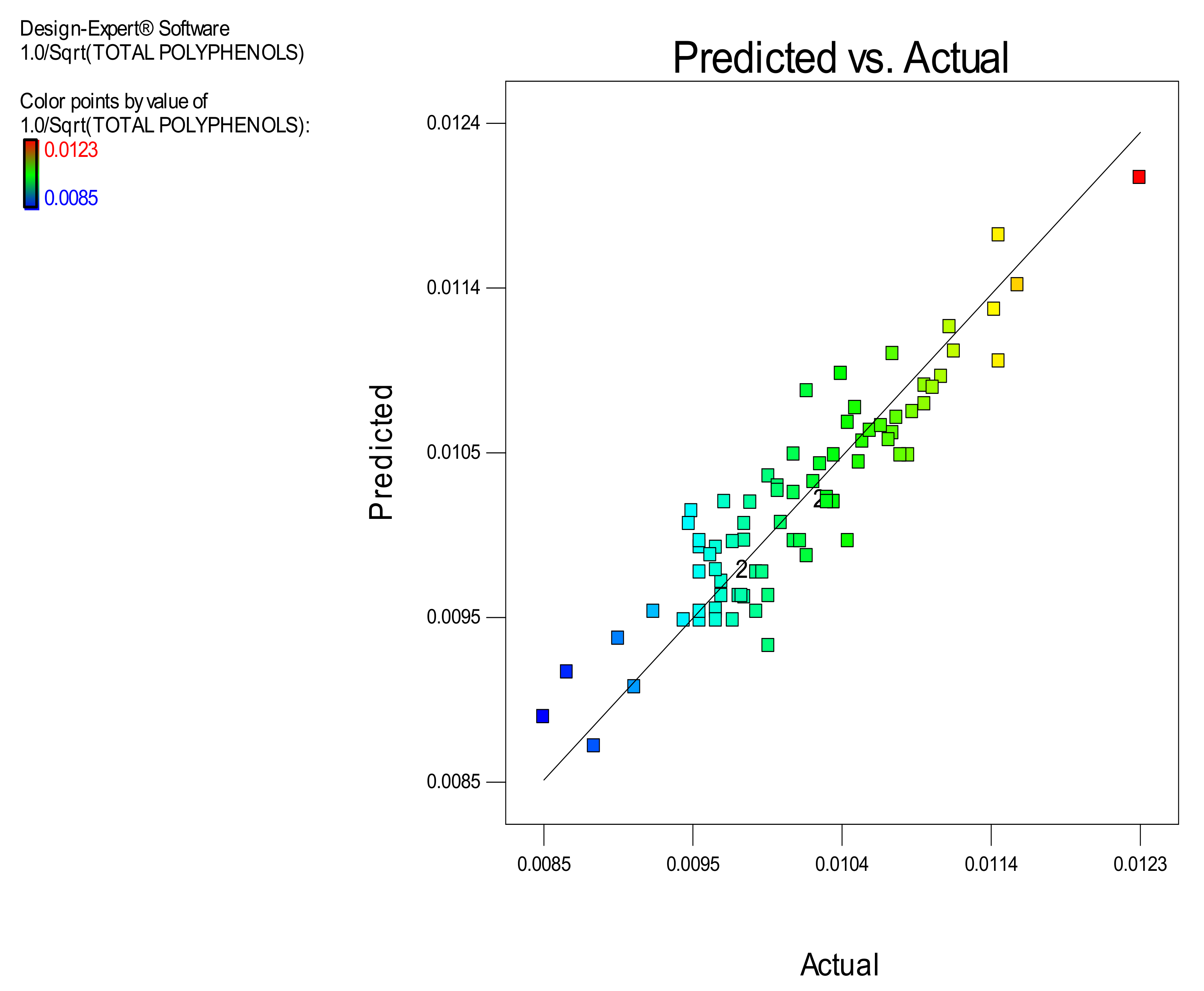
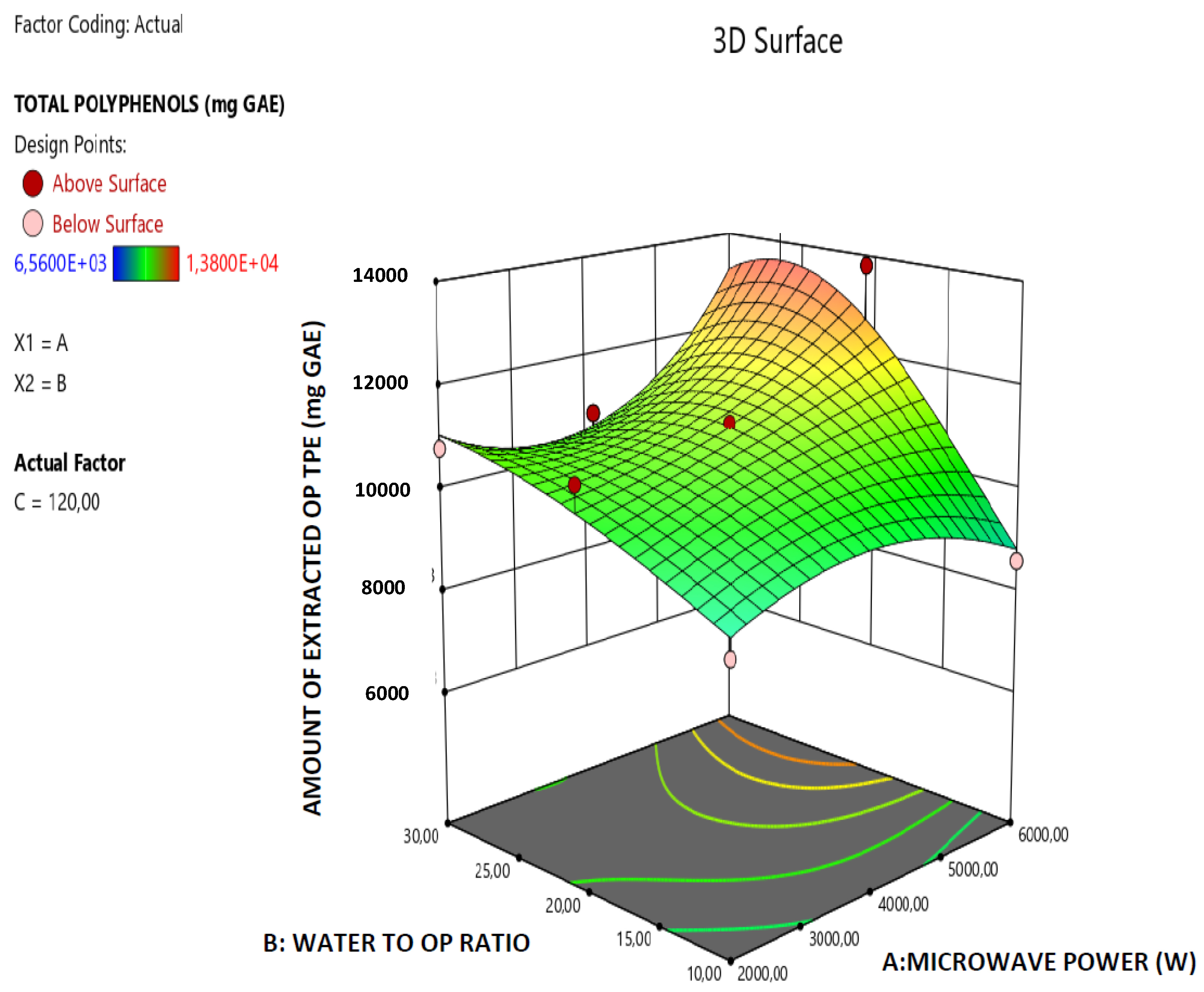
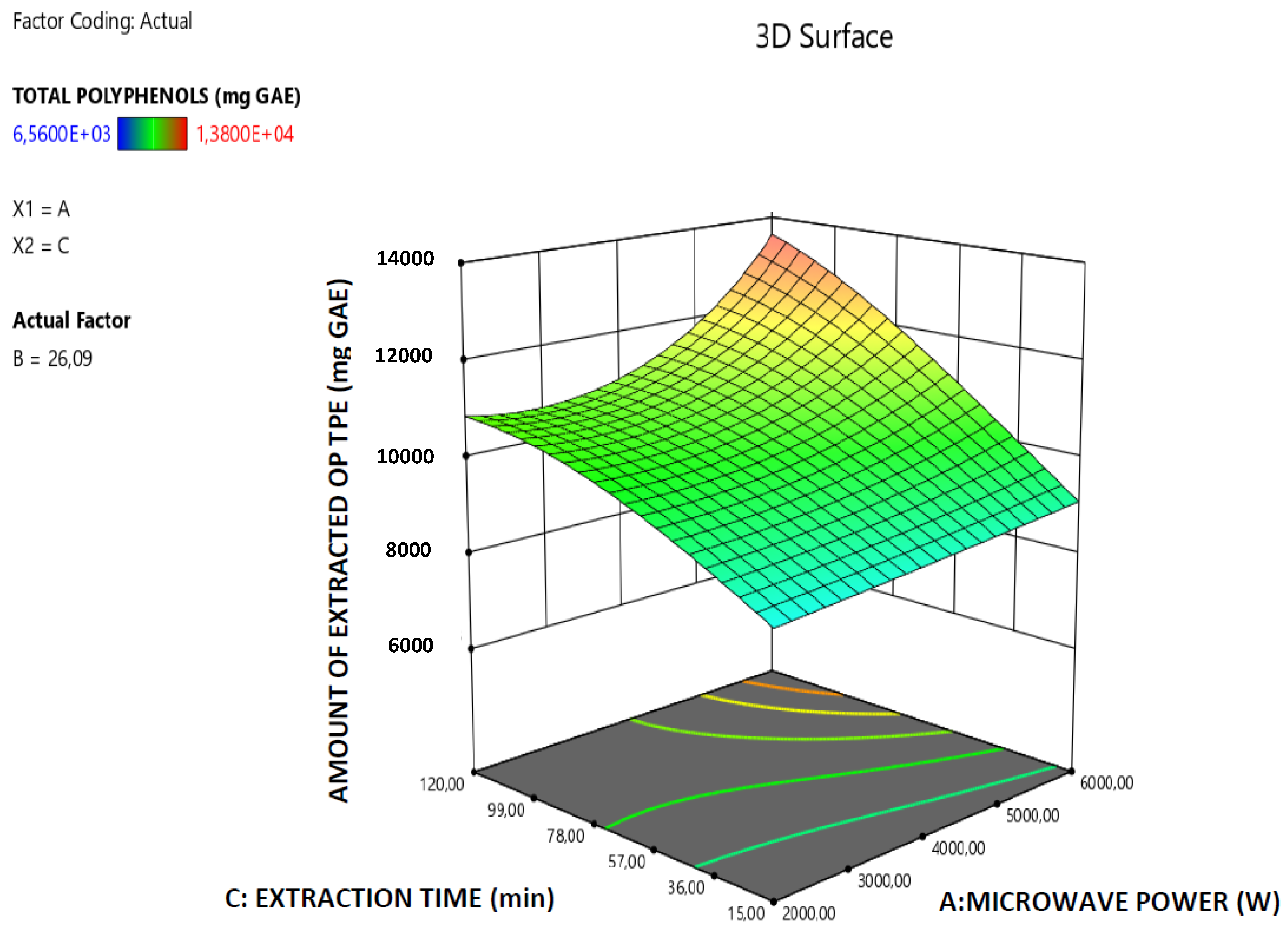
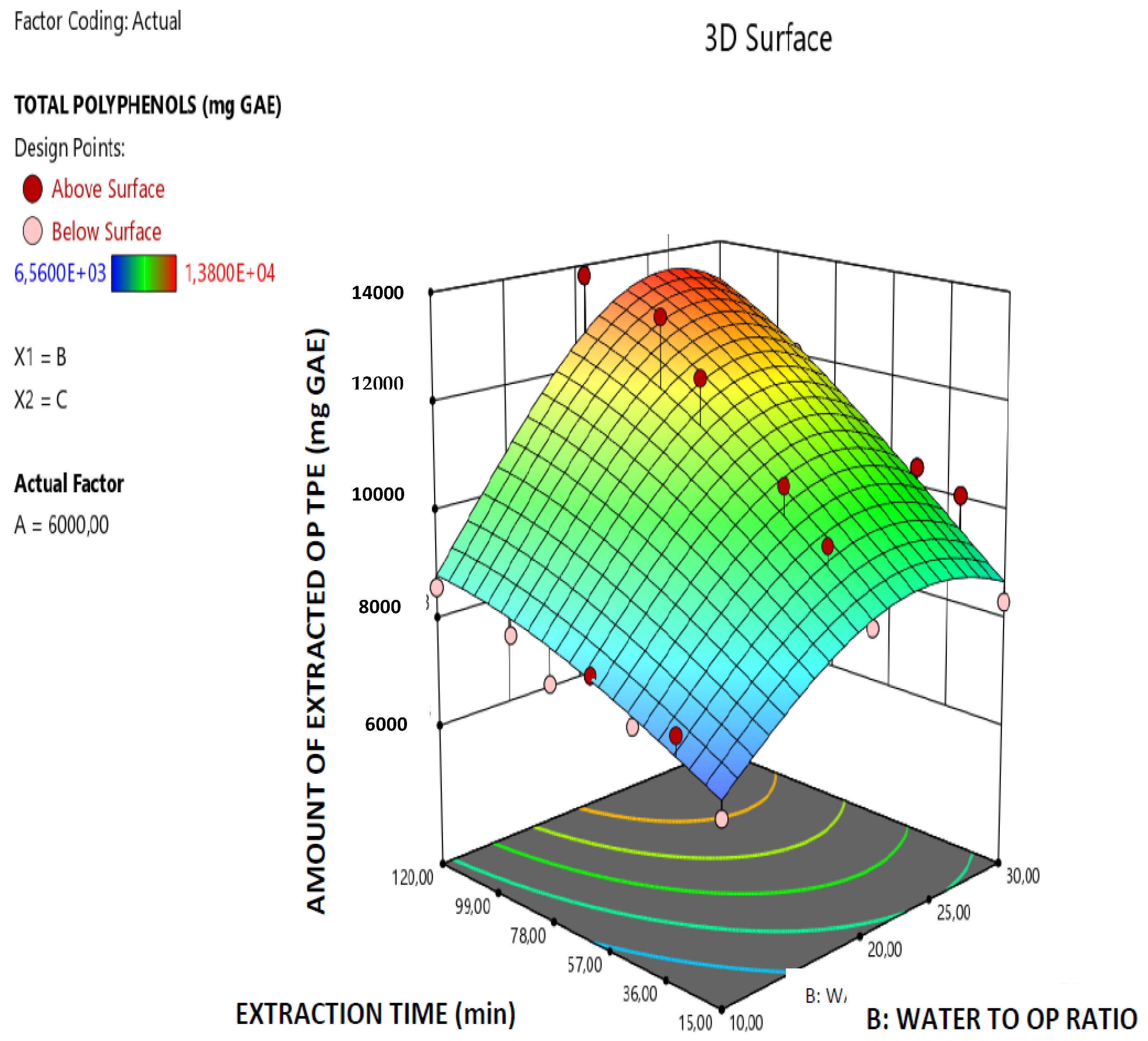
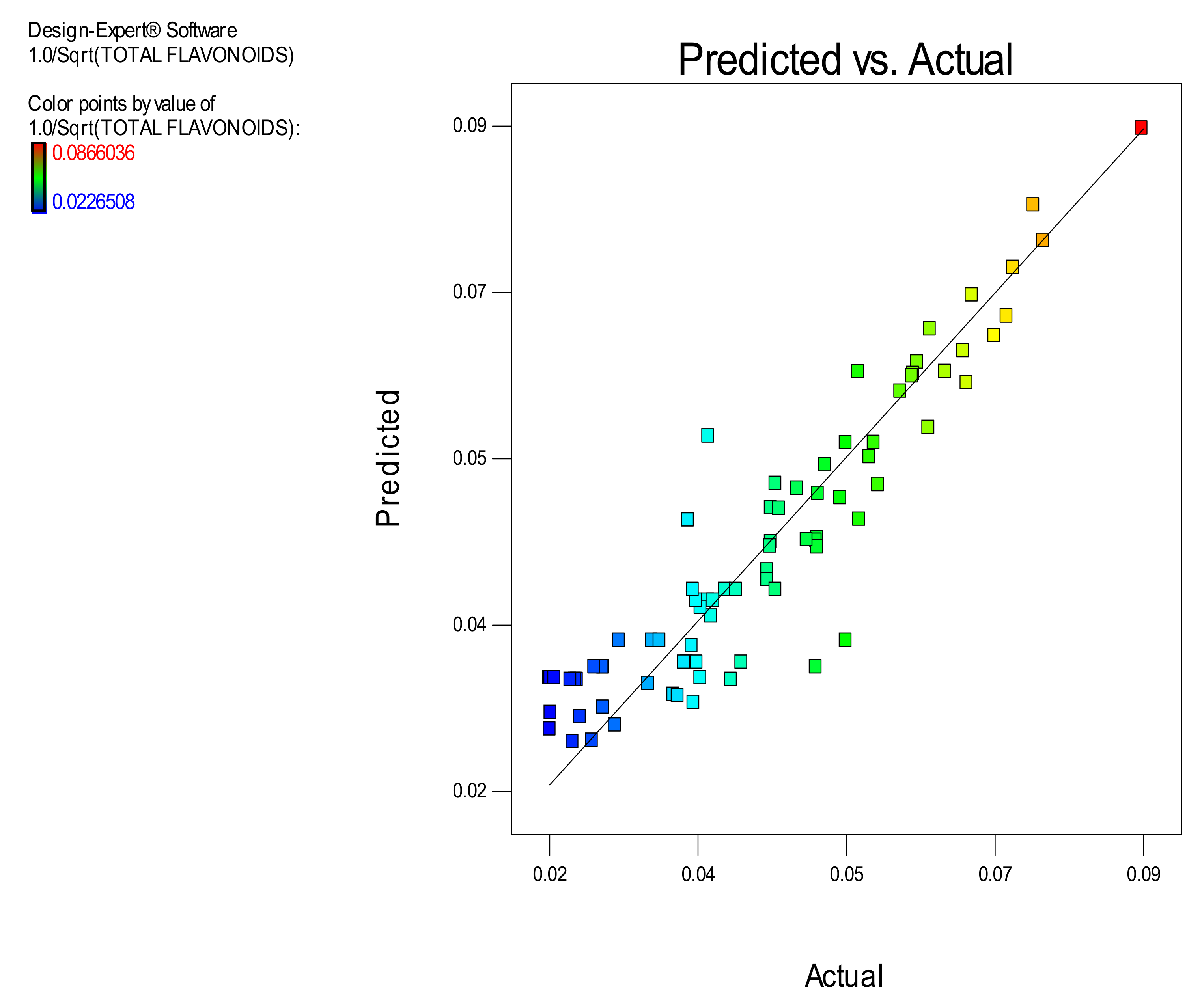
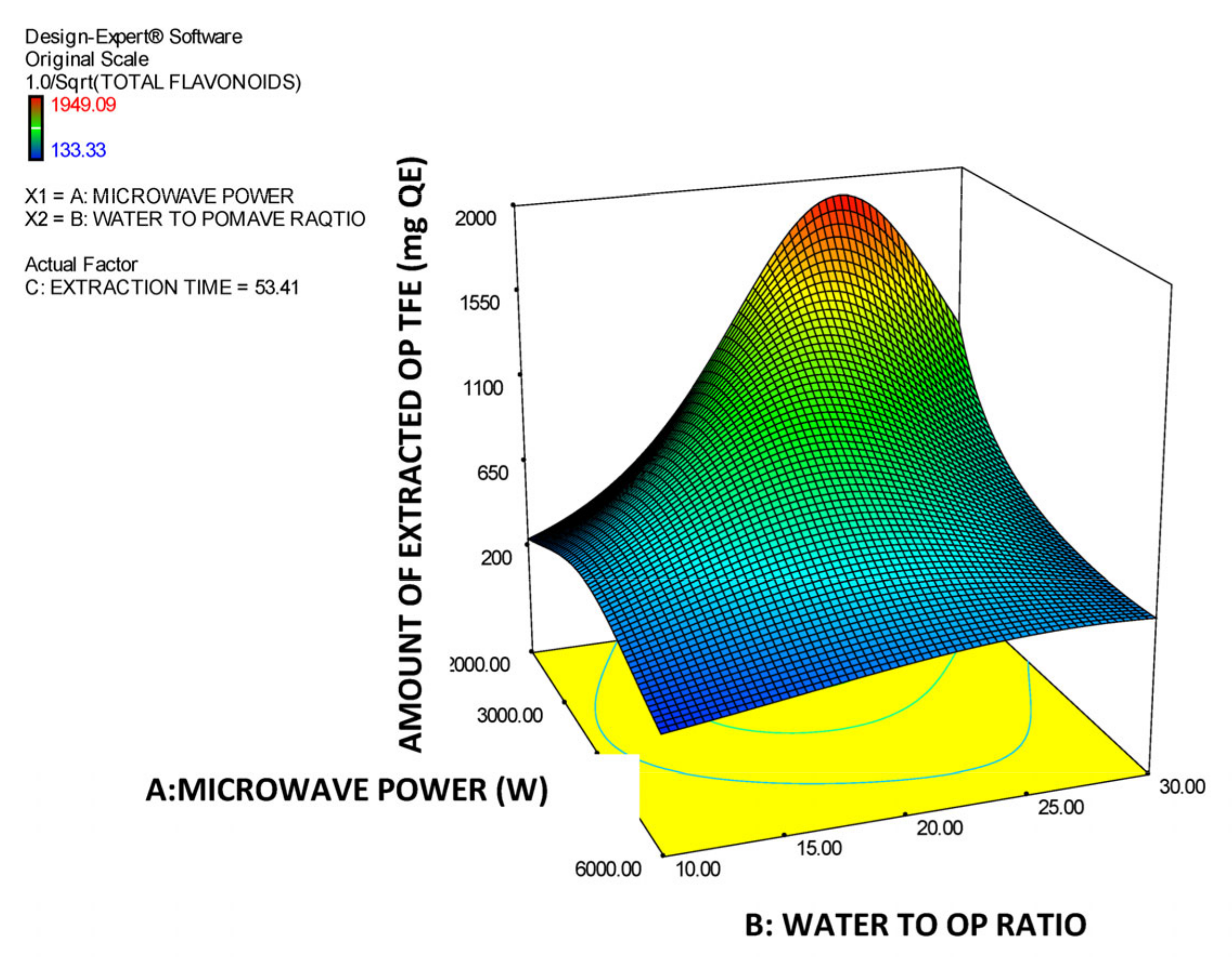
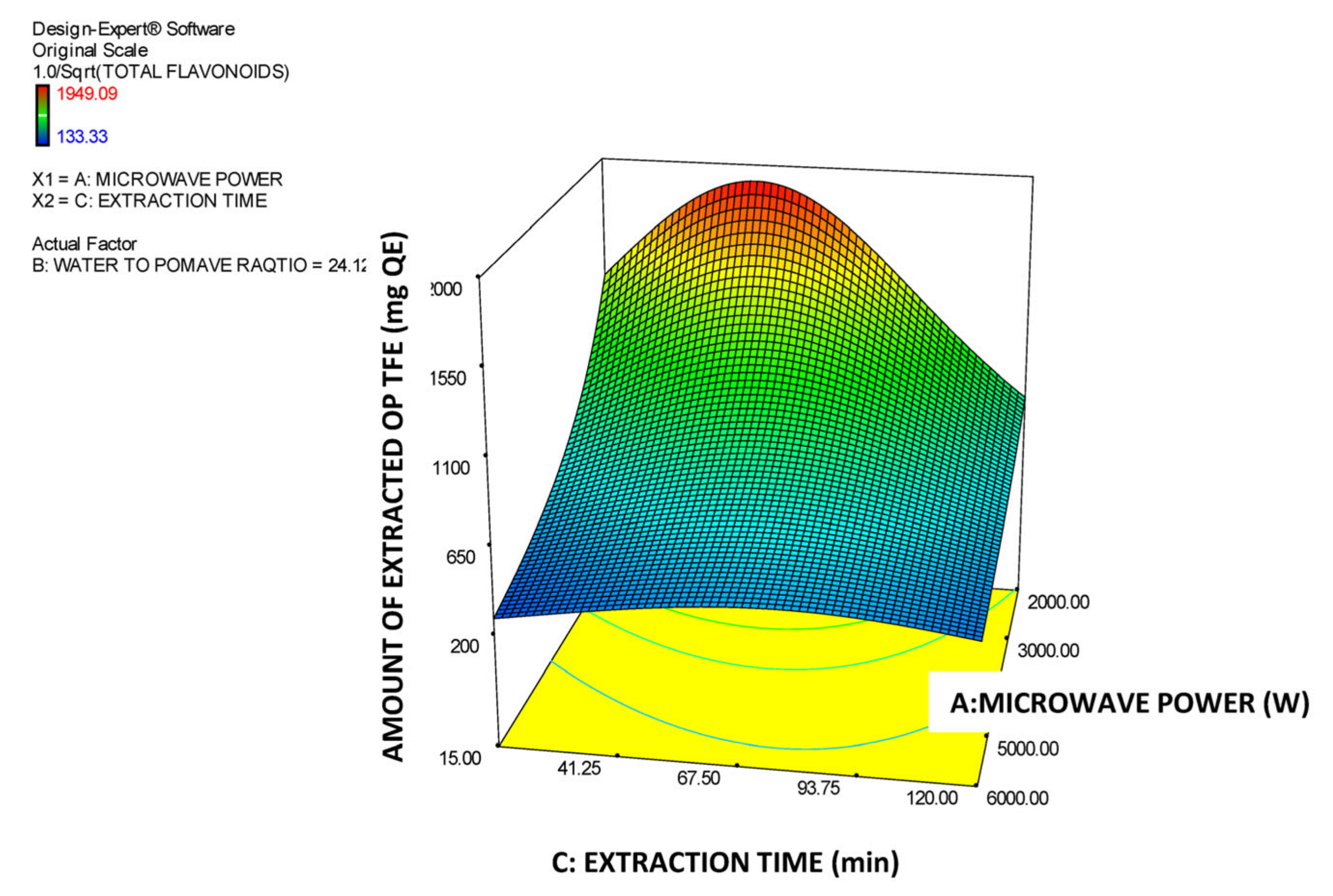
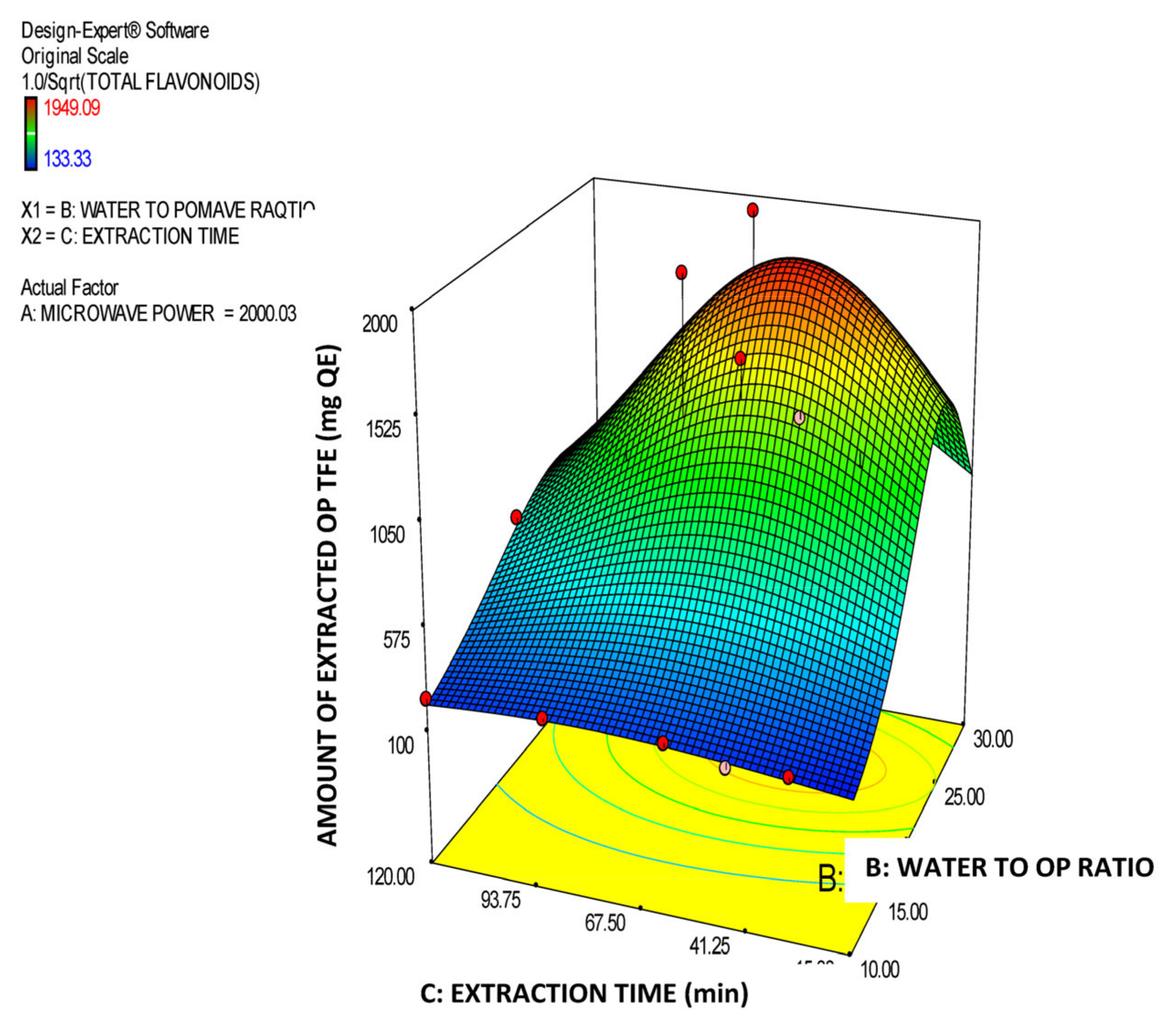
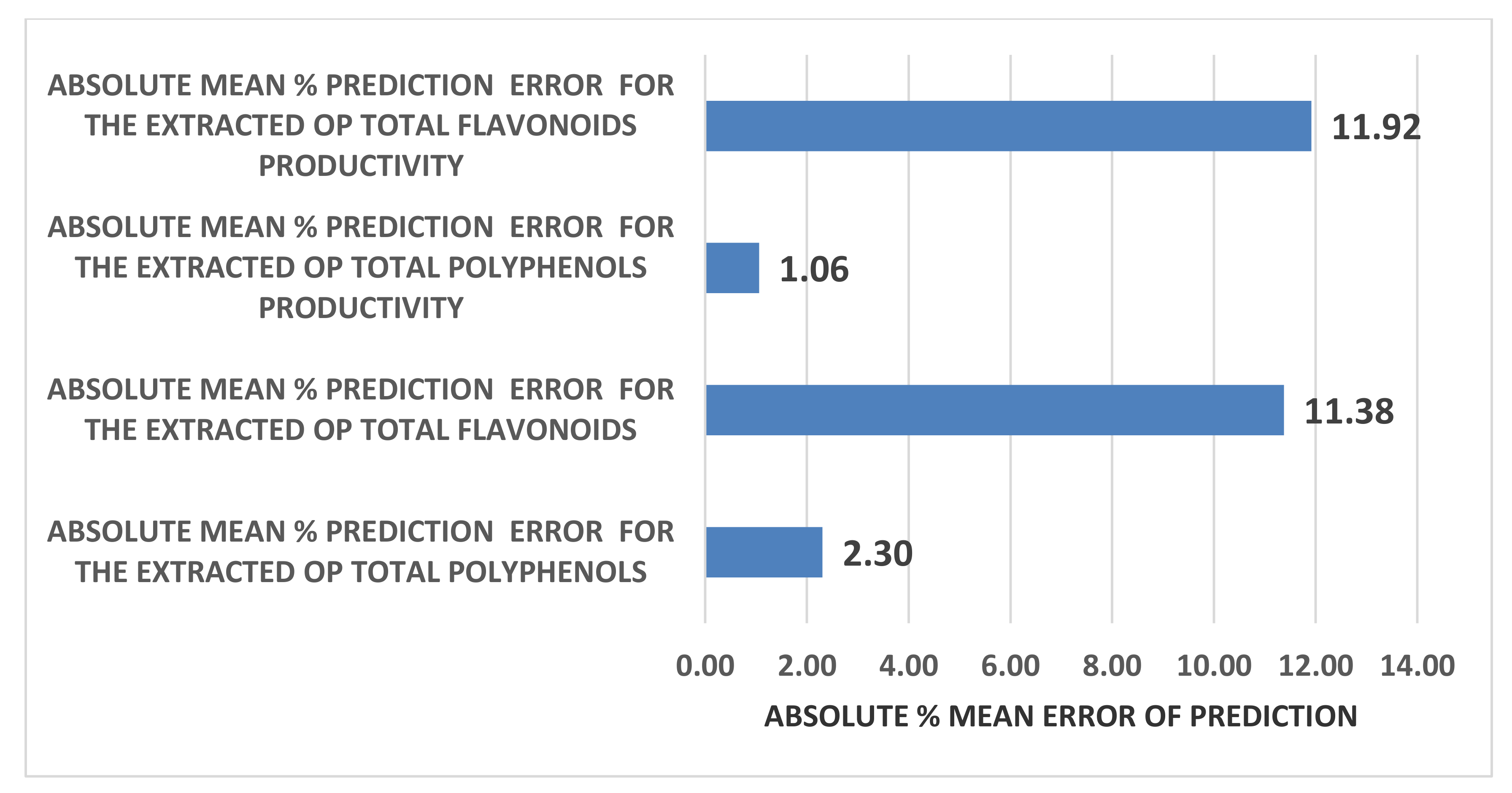
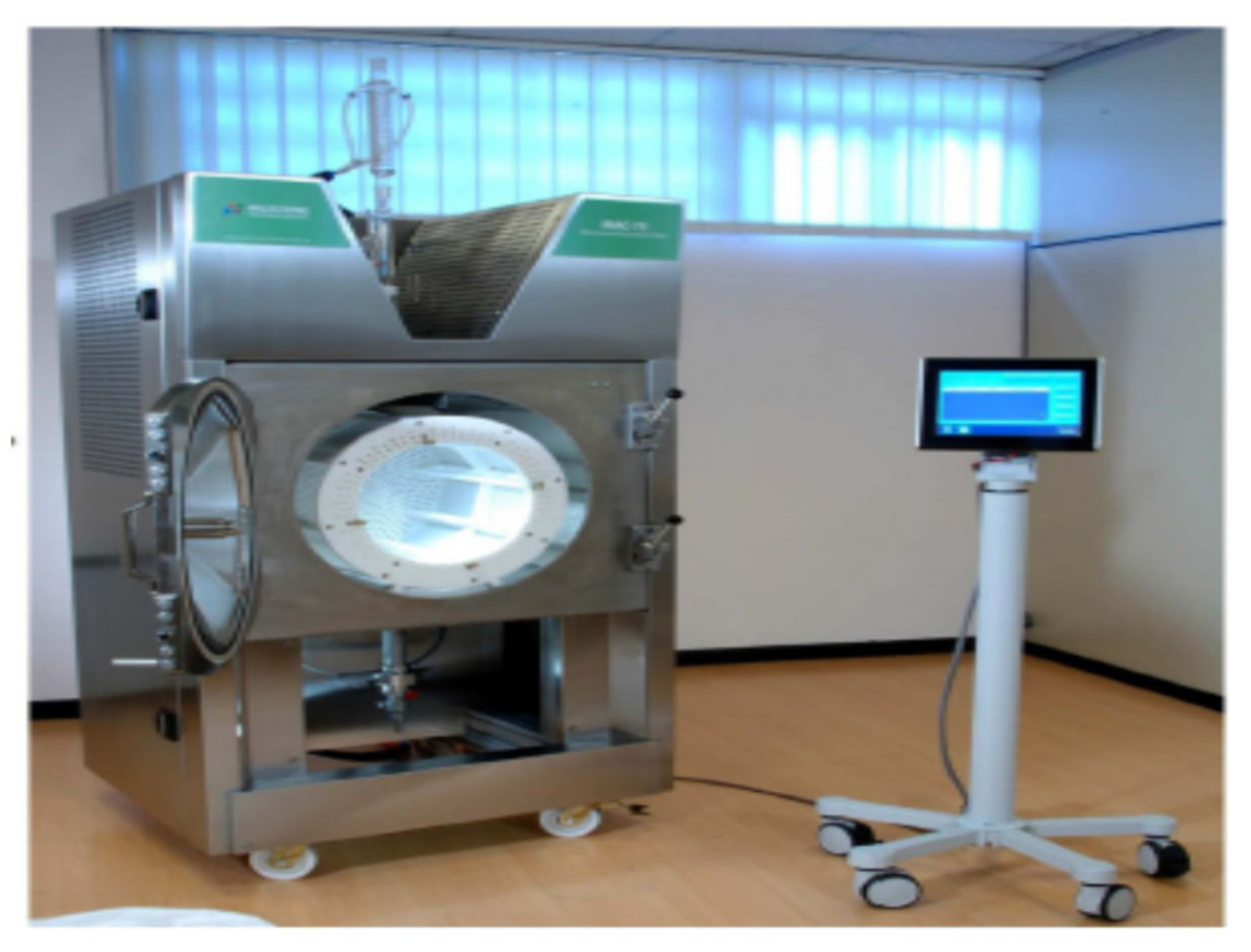
| Optimized Extraction Conditions | Optimized Antioxidant Parameters | ||||
|---|---|---|---|---|---|
| Optimization Target | Microwave Power (W) | Water/OP Ratio | Extraction Time (min) | Maximum of Extracted OP Total Polyphenols (mg GAE per 2 Kg Raw OP) | Maximum of Extracted OP Total Flavonoids (mg QE per 2 Kg Raw OP) |
| Total polyphenols | 5999.997 | 26.09 | 120.00 | 13,559.802 | |
| Total flavonoids | 2000.00 | 24.12 | 53.45 | 1909.27 | |
| Total polyphenols + Total flavonoids | 2000.00 | 24.95 | 63.96 | 9977.48 | 1847.42 |
| a/a | t Value | p Value | Statistical Significance (2-Tailed) Significance Level = 0.05 | |
|---|---|---|---|---|
| 1 | Pair 1 PM-PP | −0.17411 | 0.862004 | p value = 0.862004 > 0.05 therefore no significant difference between predicted and measured amounts of OP total polyphenols |
| 2 | Pair 2 FM-FP | −0.02704 | 0.978465 | p value = 0.978465 > 0.05 therefore no significant difference between predicted and measured amounts of OP total flavonoids. |
| 3 | Pair 3 PRM-PRP | 0.01359 | 0.989174 | p value = 0.989174 > 0.05 therefore no significant difference between predicted and measured extraction rate values of OP total polyphenols |
| 4 | Pair 4 FRM-FRP | −0.01204 | 0.990407 | p value = 0.990407 > 0.05 therefore no significant difference between predicted and measured extraction rate values of OP total flavonoids |
| (1) PM—measured values of extracted total OP polyphenols (2) PP—predicted values of extracted total OP polyphenols (3) FM—measured values of extracted total OP flavonoids (4) FP—predicted values of extracted total OP flavonoids (5)PRM—measured values of the rate of extracted total OP polyphenols (6)PRP—predicted values of the rate of extracted total OP polyphenols (7)FRM—measured values of the rate of extracted total OP flavonoids (8)FRM—predicted values of the rate of extracted total OP flavonoids | ||||
Publisher’s Note: MDPI stays neutral with regard to jurisdictional claims in published maps and institutional affiliations. |
© 2021 by the authors. Licensee MDPI, Basel, Switzerland. This article is an open access article distributed under the terms and conditions of the Creative Commons Attribution (CC BY) license (http://creativecommons.org/licenses/by/4.0/).
Share and Cite
Petrotos, K.; Giavasis, I.; Gerasopoulos, K.; Mitsagga, C.; Papaioannou, C.; Gkoutsidis, P. Optimization of Vacuum-Microwave-Assisted Extraction of Natural Polyphenols and Flavonoids from Raw Solid Waste of the Orange Juice Producing Industry at Industrial Scale. Molecules 2021, 26, 246. https://doi.org/10.3390/molecules26010246
Petrotos K, Giavasis I, Gerasopoulos K, Mitsagga C, Papaioannou C, Gkoutsidis P. Optimization of Vacuum-Microwave-Assisted Extraction of Natural Polyphenols and Flavonoids from Raw Solid Waste of the Orange Juice Producing Industry at Industrial Scale. Molecules. 2021; 26(1):246. https://doi.org/10.3390/molecules26010246
Chicago/Turabian StylePetrotos, Konstantinos, Ioannis Giavasis, Konstantinos Gerasopoulos, Chrysanthi Mitsagga, Chryssoula Papaioannou, and Paschalis Gkoutsidis. 2021. "Optimization of Vacuum-Microwave-Assisted Extraction of Natural Polyphenols and Flavonoids from Raw Solid Waste of the Orange Juice Producing Industry at Industrial Scale" Molecules 26, no. 1: 246. https://doi.org/10.3390/molecules26010246
APA StylePetrotos, K., Giavasis, I., Gerasopoulos, K., Mitsagga, C., Papaioannou, C., & Gkoutsidis, P. (2021). Optimization of Vacuum-Microwave-Assisted Extraction of Natural Polyphenols and Flavonoids from Raw Solid Waste of the Orange Juice Producing Industry at Industrial Scale. Molecules, 26(1), 246. https://doi.org/10.3390/molecules26010246








